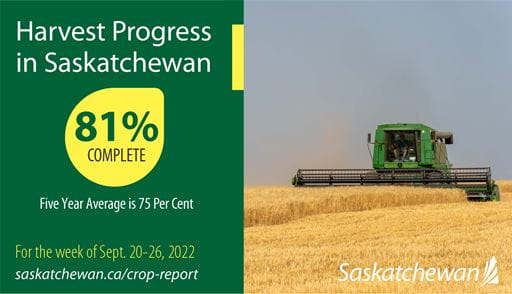Released on September 29, 2022
Producers in the southwest and west-central regions are mostly done harvest and are now completing other field work, while others were slowed down by cool, damp weather. Harvest progress reached 81 per cent this week, up from 73 per cent last week and still ahead of the five-year (2017-2021) average of 75 per cent. Many producers in the eastern and northern areas of the province are waiting for canola stems to dry down or for some warm, windy days to lower the moisture content of cereal grains.
Harvest is most advanced in the southwest region, where 98 per cent of the crop is now combined. The west-central region has 97 per cent, the southeast 74 per cent, the northwest 70 per cent, the northeast 69 per cent and the east-central has 65 per cent of their crop harvested.
The harvest of lentils and field peas across the province is virtually complete. Ninety-six per cent of durum, 94 per cent of chickpeas, 86 per cent of barley, 83 per cent of spring wheat and 66 per cent of canola has been harvested so far. There is an additional 26 per cent of canola ready to be swathed or straight-cut.
Small amounts of rainfall were received across the province last week, with the most falling in the northeast and southeast regions. The Bienfait and Melfort areas received 35 mm, the Calder area 14 mm and the Marengo area four mm. Other areas in the province received anywhere from trace amounts up to 10 mm.

Cropland topsoil moisture is rated as one per cent surplus, 34 per cent adequate, 35 per cent short and 30 per cent very short. Hay and pasture land topsoil moisture is rated as one per cent surplus, 27 per cent adequate, 39 per cent short and 33 per cent very short.
Some areas are reporting moderate to severe on-site water shortages. Those producers are reporting that the situation is getting worse each week they don't receive rain. Producers are hauling water, bringing livestock closer to home or are drilling new wells to replace depleted or unsafe water sources.
The majority of crop damage this week was due to wind, waterfowl and wildlife. Wind continues to impact unharvested crops by blowing swaths around, shelling out crops and causing lodging. Frost would be helpful for producers who are struggling with green stems as it will kill off green growth and reduce the need for herbicide applications.
Producers are busy combining, hauling grain, hauling bales, moving cattle and starting other fall field work, such as post-harvest weed control and harrowing. Winter cereals cannot be planted in many areas due to the extreme lack of soil moisture. Fall fertilizer applications are also not possible in many regions due to the dry conditions.
A complete, printable version of the Crop Report is available online at https://www.saskatchewan.ca/crop-report.
Follow the 2022 Crop Report on Twitter at @SKAgriculture.
-30-
For more information, contact:
Matthew Struthers
Agriculture
Moose Jaw
Phone: 306-694-3714
Email: matt.struthers@gov.sk.ca

